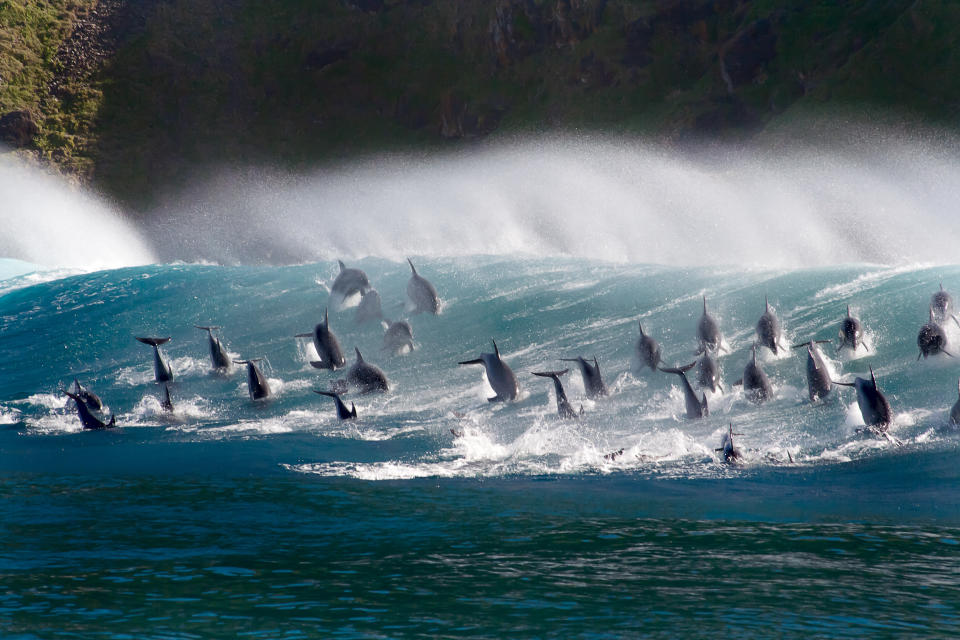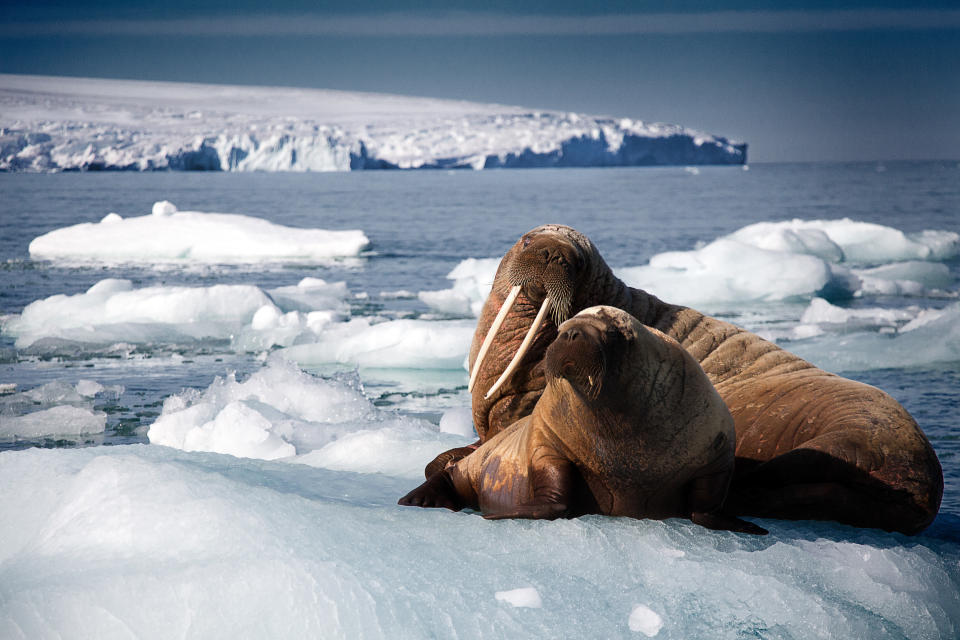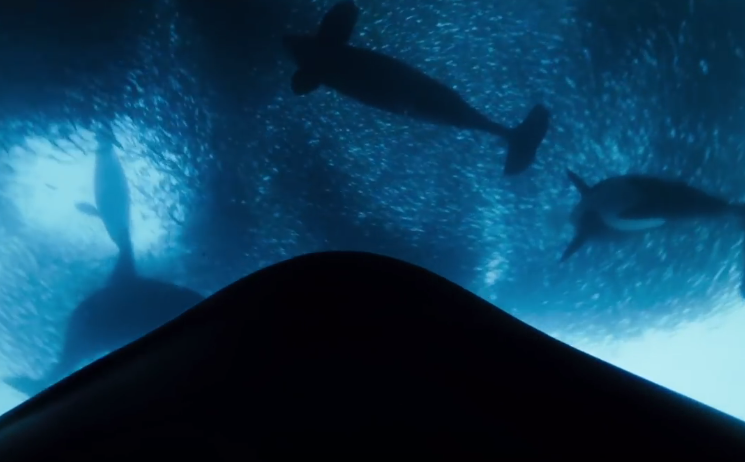'Blue Planet II' premiere: Bird-eating fish and 5 more sequences you'll be talking about
Planet Earth: Blue Planet II, the eight-part follow-up to the Emmy-winning 2001 nature documentary series, was the top-rated show of 2017 in the U.K. This Saturday, the journey, narrated by Sir David Attenborough, finally begins on BBC America.
Most viewers are aware that oceans cover 70 percent of Earth. But over the course of four years in production, Blue Planet II teams filmed behaviors many of us never would have imagined. Here, executive producer James Honeyborne offers a preview of six of the sequences that will wow you in the Jan. 20 premiere, “One Ocean.”
1. A bird-eating fish
In the sneak peek above, you see how the giant trevally preys on terns in the Indian Ocean. Some fledgling fliers may not yet be aware of the danger that lurks beneath when they take an ill-fated rest on the surface of the water. Others are cautious and even drink on the move, which is why these fish have learned to propel themselves out of the water. “When we first heard of this, it was literally a fisherman’s tale — one fisherman in South Africa told us this might be happening somewhere in the Indian Ocean. There was no photographic evidence of it. It was quite a risk, I suppose, to dedicate a team to go and get it, but there was just enough anecdotal evidence for us to think, ‘Yeah, this really could be happening if we went at the right time of year,’” Honeyborne says.
Once the team was in place, they had to figure out where the behavior was happening — and how they could film it. “It’s very much edited highlights from over a long period of time,” Honeyborne says. “We actually went back a second year to get more detail of it all. The wonderful thing that you see at the end is that there are an awful lot of birds that have got by. But there’s this terrible moment when the first ones go out and they’re tired and they don’t realize there’s a threat. To me, that’s an iconic sequence, and it’s a highly impactful sequence, not just for the behavior, but also because it just reminds us of how much there must be out there that we don’t know.”
The music, composed by Hans Zimmer and the team at Bleeding Fingers, has to reflect that drama, Honeyborne adds. (Keep an ear out for a moment not in our clip, when the focus is on one young bird on shore gearing up for its first flight. We think we hear an inspired homage to Zimmer’s Man of Steel soundtrack.)

2. Surfing bottlenose dolphins
The episode opens by taking viewers right into the monster waves of South Africa’s Wild Coast, where intelligent, playful, social dolphins surf for the thrill of it. “What I love about these big wildlife series is that there’s potential to engage the audience with a range of emotions,” Honeyborne says. “Sometimes some of these big series in the past have relied very heavily on getting a response of awe and wonder. But I loved the idea of starting with joy, because joy’s not a reaction that many people naturally think they’ll feel about the sea. There’s something so joyful about just watching these dolphins have fun.”
Each episode of Blue Planet II saves time at the end for a “making of” segment (those are also then combined to form the final installment of the series). The premiere closes with a glimpse at the lengths to which surf cameraman Chris Bryan went to get these shots. The footage of him being chased back to shore by a massive wave while on the back of a Jet Ski — and holding on with just one hand because his other arm is wrapped around his camera — is equally epic. (Ultimately, Bryan needed to shoot from aboard a Zodiac boat to have a steady shot and access to different angles.)

3. A fierce mother walrus and her cub
We’ve all seen disturbing footage of hungry polar bears in the arctic, where, over the last 30 years, the amount of ice in the summer has been reduced by 40 percent due to climate change. But the premiere tells a different, heartbreaking story: the struggle of mother walruses to find their young cubs safe places to rest. On land, the cubs are easy prey for polar bears, so they’re forced back into the water, where they have the advantage. But with fewer pieces of ice to eventually rest upon, they face a different danger. “There’s a very specific problem with the reduced number of haul-outs for these mothers. It’s not impossible for a baby walrus to get hypothermia, so it’s very important that they get their babies out of the water,” Honeyborne says. “The overall narrative in the first episode is how the oceans are all connected and how together they do an amazing service to the planet, and yet they’re changing very fast. That data’s very clear; it’s from NASA and NOAA [National Oceanic and Atmospheric Administration]. It’s a new situation for these creatures. It felt like an important story to tell.” (The challenges that mother and cub face together create a bond so strong, the mother will stay in contact with the cub for as long as she lives.)

4. Orcas tumbling for herring
Episode 7 of Blue Planet II will focus more on the human-made damage being done to the oceans — and the people devoting their lives to reversing it. But this killer whale sequence in Episode 1 proves there is hope, if we’re willing to make changes. Back in the late 1960s, herring had all but disappeared from the fjords of Norway, and orcas were being killed because they were viewed as fishermen’s rivals for the fish. But by regulating the fishery and protecting the whales, both populations are now thriving — so much so that a billion herring pour in during the winter, attracting 1,000 orcas. The killer whales hunt in pods, herding the herring into tighter and tighter shoals. An orca will then do a backflip to beat its tail into the bait ball, stunning a number of herring at one time — which it shares with the other killer whales.
“What was fascinating was when we got the sucker camera on an orca, and that didn’t happen until the third season we were filming that. We had tried, unsuccessfully, with scientists in the previous seasons. That orca [with the camera] took us straight into a hunt,” Honeyborne says. “It’s a fascinating and compelling moment when you see that for the first time. We’re riding on the back of an orca into a shoal of herring being hunted by a whole family of orca. What’s lovely about these cameras is that they’re recording sound as well, so we can hear the orca communicating to each other. We can see very clearly how when one goes in and does that tumble-turn tail slap, they all then seem to share the food, and we can see very clearly that up to 30 herring are stunned with each tail slap. There’s a lot of scientific data that’s useful to the top scientists as well, so they were thrilled to get that material.”
5. False killer whales and bottlenose dolphins
Another sequence that takes an unexpected turn: when false killer whales off New Zealand begin to chase a large pod of dolphins. Are they trying to catch up to them to attack them? you’ll wonder. But then the dolphins turn around and … greet them? “It’s extraordinary. I think there’s a theme running all the way through the first episode of intelligence in marine creatures, whether it’s mammals or fish,” Honeyborne says. “So I think there’s that sense of wonder at the intelligence and sophistication, that two different species can come together and seemingly try to communicate with each other, and certainly, they appear to be old friends, because the same individual false killer whale and the same individual bottlenose dolphin seem to team up year after year. So they seem to recognize each other. The scientists are doing the research into the vocalization at the moment. There was a limit to how much we could say for sure, and that’s one of the excitements of the series, actually, is that we’re still understanding a lot of this. It was just amazing to us that false killers, which could be deadly to dolphins, actually choose to collaboratively team up to make the most of what might be out there in the big blue.”
6. Mobula rays in the Sea of Cortez
“That’s just a glorious sequence. There’s something magical about it,” Honeyborne says of large mobula rays rubbing up against bioluminescent plankton while feeding on shrimp in the dark of night — and creating a twinkling sea. (The accompanying score in the episode makes you imagine a dance in Cinderella.) “It’s there, hopefully, to remind us of the magic and wonders of the oceans. But of course, when we set out to film that, we didn’t have cameras that were light-sensitive enough to capture it back in 2013, ’14,” Honeyborne says. “We had to literally wait for the camera sensor technology to catch up. It was only about 2016 that we could go out there and film it with confidence.”
Planet Earth: Blue Planet II premieres Jan. 20 at 9 p.m. as an AMC Networks simulcast event across BBC America, AMC, IFC, WE tv, and SundanceTV. Subsequent episodes will air on BBC America.
Read more from Yahoo Entertainment:

